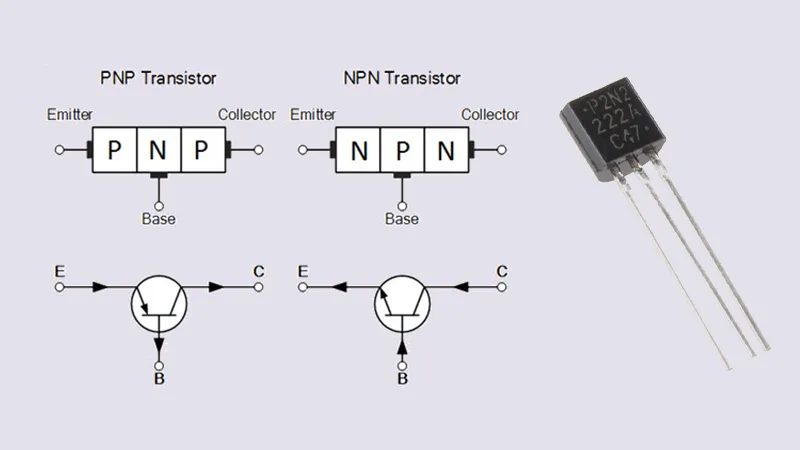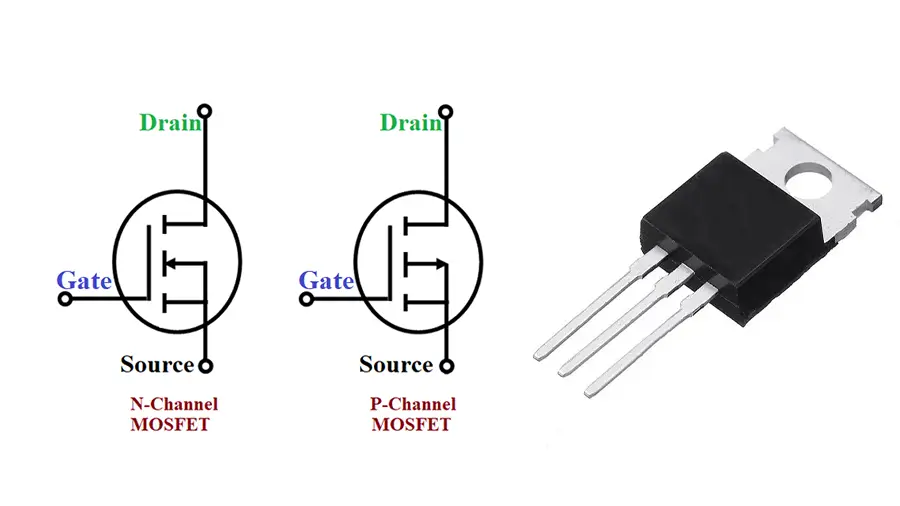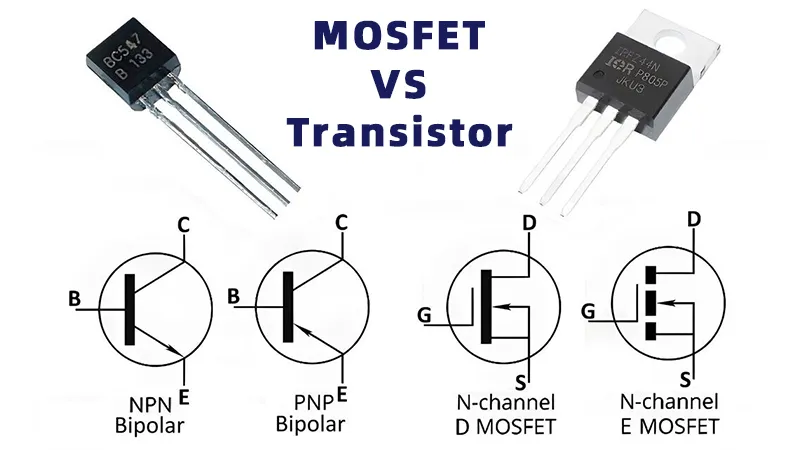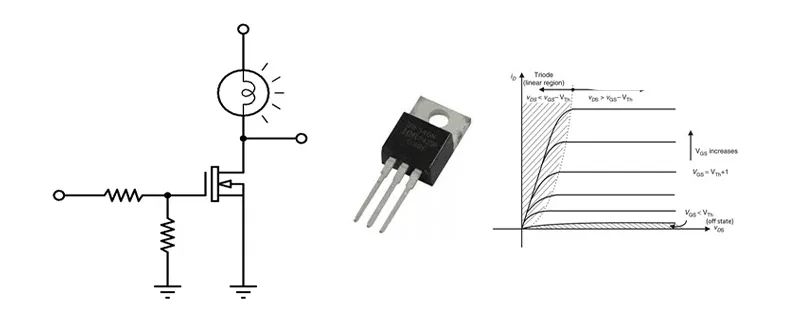In the realm of electronics, the debate between MOSFETs and transistors is ongoing, each having its unique advantages and disadvantages. These components are crucial in a wide array of applications, from simple switching tasks to complex amplification.
This article aims to explore the key differences, benefits, and drawbacks of MOSFETs and transistors, addressing common questions.
What is a Transistor?

A transistor, short for “transfer resistor,” is a semiconductor device used to amplify or switch electronic signals and electrical power. There are two primary types of transistors: Bipolar Junction Transistors (BJTs) and Field-Effect Transistors (FETs).
Bipolar Junction Transistors (BJTs)
BJTs are composed of three layers of semiconductor material, forming two p-n junctions. They are classified into two types: NPN and PNP. The main function of BJTs is to amplify current. They have three terminals: the emitter, base, and collector.
What is a MOSFET?

A MOSFET (Metal-Oxide-Semiconductor Field-Effect Transistor) is a type of FET that controls the flow of electricity between the source and drain terminals using a voltage applied to the gate terminal. MOSFETs are widely used due to their efficiency and fast switching capabilities.
Types of MOSFETs
MOSFETs are categorized into two main types:
- N-channel MOSFETs: Allow current to flow when a positive voltage is applied to the gate.
- P-channel MOSFETs: Allow current to flow when a negative voltage is applied to the gate.
Key Differences: What is the Difference Between MOSFET and Transistor?

Understanding the differences between MOSFETs and transistors is essential for selecting the right component for specific applications. Here are some critical distinctions:
Structure and Operation
- BJTs: Operate based on current control, where a small base current controls a larger current between the collector and emitter.
- MOSFETs: Operate based on voltage control, where a voltage applied to the gate controls the current flow between the source and drain.
Efficiency
- MOSFETs: Generally more efficient, especially in high-speed switching applications due to lower power consumption.
- BJTs: Can be less efficient in switching applications due to higher power dissipation.
Switching Speed
- MOSFETs: Offer higher switching speeds, making them ideal for high-frequency applications.
- BJTs: Typically have slower switching speeds compared to MOSFETs.
Thermal Stability
- MOSFETs: Better thermal stability and can handle higher power levels without significant performance degradation.
- BJTs: Less thermally stable and may suffer from thermal runaway in high-power applications.
Input Impedance
- MOSFETs: Have high input impedance, which means they draw very little current from the input source.
- BJTs: Have lower input impedance, which can be a drawback in some applications.
| Aspect | MOSFETs | BJTs |
|---|---|---|
| Structure and Operation | Operate based on voltage control, where a voltage applied to the gate controls the current flow between the source and drain. | Operate based on current control, where a small base current controls a larger current between the collector and emitter. |
| Efficiency | Generally more efficient, especially in high-speed switching applications due to lower power consumption. | Can be less efficient in switching applications due to higher power dissipation. |
| Switching Speed | Offer higher switching speeds, making them ideal for high-frequency applications. | Typically have slower switching speeds compared to MOSFETs. |
| Thermal Stability | Better thermal stability and can handle higher power levels without significant performance degradation. | Less thermally stable and may suffer from thermal runaway in high-power applications. |
| Input Impedance | Have high input impedance, which means they draw very little current from the input source. | Have lower input impedance, which can be a drawback in some applications. |
Transistor vs MOSFET as Switch

Both MOSFETs and transistors are widely used as switches in various applications. Here’s a comparison of their use as switches:
MOSFET as a Switch
MOSFETs are highly efficient as switches due to their fast switching speeds and low on-resistance. They are commonly used in:
- Power Supplies: MOSFETs are ideal for switching power supplies due to their high efficiency and fast switching capabilities.
- Motor Drives: Used in controlling motors where precise speed control is required.
- Digital Circuits: Widely used in digital circuits for switching applications due to their high input impedance and fast response.
BJT as a Switch
BJTs can also be used as switches, though they are generally less efficient compared to MOSFETs. They are commonly found in:
- Analog Circuits: BJTs are often preferred in analog circuits due to their superior linearity and gain characteristics.
- Low-Power Applications: Suitable for low-power applications where switching speed is not critical.
Choosing the Right Component
The choice between MOSFETs and BJTs depends on the specific requirements of the application. Here are some guidelines:
When Would You Use a MOSFET?
- High-Frequency Switching: If your application requires high-speed switching, MOSFETs are the best choice.
- High Efficiency: For applications where power efficiency is critical, such as power supplies and battery-operated devices.
- Thermal Management: When thermal stability is a concern, MOSFETs provide better performance.
When to Choose BJTs?
- Analog Applications: BJTs excel in analog circuits due to their superior linearity.
- Cost-Sensitive Projects: For low-cost applications, BJTs can be a more economical choice.
- Current Amplification: In applications where high current gain is needed, BJTs are preferred.
FAQs
Is a MOSFET just a switch?
No, a MOSFET is not just a switch. While MOSFETs are commonly used as switches in electronic circuits due to their high efficiency and fast switching speeds, they also serve other functions. MOSFETs can be used in amplification, signal modulation, and power management applications. Their ability to handle high voltages and currents makes them versatile components in various electronic devices.
Are MOSFETs still used?
Yes, MOSFETs are widely used in modern electronics. They are essential components in power supplies, motor drives, digital circuits, and many other applications. Their efficiency, fast switching capabilities, and high input impedance make them a preferred choice in both consumer electronics and industrial applications.
Do MOSFETs use AC or DC?
MOSFETs can handle both AC and DC signals. However, they are primarily used in DC applications due to their excellent switching characteristics and efficiency. In AC applications, MOSFETs are often used in conjunction with other components to manage the switching and control of AC signals.
Do inverters use MOSFETs?
Yes, inverters commonly use MOSFETs. Inverters convert DC power to AC power, and MOSFETs are used in the switching circuits of inverters to efficiently control the conversion process. The fast switching speeds and low power dissipation of MOSFETs make them ideal for this application, improving the overall efficiency of the inverter.
Do MOSFETs have to be grounded?
MOSFETs do not necessarily have to be grounded, but proper grounding is essential for stable operation and to prevent noise and interference in the circuit. In many designs, the source terminal of an N-channel MOSFET or the drain terminal of a P-channel MOSFET is connected to ground, depending on the configuration. Ensuring correct grounding and layout practices is crucial for optimal performance of MOSFETs in electronic circuits.
Conclusion
In the debate of MOSFET vs Transistor, each component has its own set of advantages and drawbacks. Understanding the differences and specific use cases can help in selecting the right component for your application.
Whether you need high-speed switching, efficient power management, or superior analog performance. By considering the pros and cons of each, you can optimize the performance and efficiency of your electronic circuits.